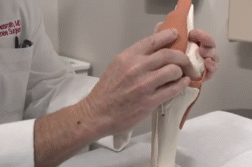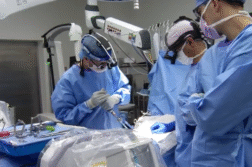Brian Cole, MD, Orthopedic Surgeon at Midwest Orthopedics at Rush and Professor in the Department of Orthopedics at Rush University Medical Center talks about a new skin closure system.
Can you explain what band grip is?
COLE: BandGrip is a new wound closure system that we’ve been using for approximately 12 months. It’s a stretchable, clear adhesive bandage that has micro anchors that will stick into the skin and help the wound stay opposed or together (minimizing tension to the skin). Traditional wound closure systems were sutures – that are often more expensive and inefficient — or staples.
Are there challenges that come with sutures and staples?
COLE: The challenge with that (sutures and staples) is that it can be very time consuming to close a wound and they require a post-operative visit for removal. That post-operative visit is time consuming and often associated with quite a bit of anxiety for the patient when the sutures have to be removed.
What have been the outcomes?
COLE: What we’ve found is that, over the last six months, patients’ acceptance has been incredibly high as well as physician and hospital acceptance. Our research showed that we reduce wound closure time (in the operating room) by 60 to 70 percent. From a cost point of view, it’s more cost effective for the hospital system. And the patient’s acceptance has been very high. The aesthetics of the wound, the way it looks post-operatively, has looked as good or better than any other wound system for closure that we’ve utilized. Oftentimes, sutures or staples can be associated with unsightly marks across the edges of the incision that can last for a long period of time and in some cases forever. In addition, our patients who are keloid formers, who lay down lots of collagen and scar, have seen an advantage in terms of the cosmetic appearance of their incision over the near and the intermediate term.
How does the patient use this BandGrip device?
COLE: The BandGrip device is a new wound closure system that is stretchy, all hypoallergenic, water resistant, and clear that allows patients to monitor their incisions in the early post-operative course. We will allow our patients to get the bandage wet. They can monitor for any adverse events such as redness or infection. And what we’ve learned, serendipitously, is that they can actually remove this very easily by themselves and avoid a post-operative visit.
What benefits are you seeing come out of this?
COLE: During the time of this COVID pandemic, our health care system has essentially turned upside down. We’ve eliminated elective office visits as well as elective surgery for the time being. We are now in a mode where we’re performing telemedicine. We can evaluate patients with acute or ongoing problems and in an urgent or emergent situation, where their care would otherwise be compromised if we don’t take care of them. We would see them in the office setting and even perform urgent or emergent surgery on a case by case basis. When we’re doing surgery, these wounds need to be closed.
What do you see moving forward?
COLE: Moving forward, we’re doing the necessary surgery in a very safe way. Then, post-operatively patients are being followed up by telemedicine where we can help guide them to wound management and removing the BandGrip dressing. However, we’ve even gone to the point now where patients can watch a simple how-to video and are given an instruction sheet so they can manage this completely independent. While initially, we advocated the advantages of the BandGrip dressing for wound closure, what we found now is this is a new way to deliver care. I believe first with the advent of telemedicine to evaluate our patients on an ongoing basis, we will be able to utilize essentially less bricks and mortar if you will where we’ll be able to treat patients telephonically through a video. We can also evolve our surgical procedures to include something like the BandGrip where we no longer have to have a post-operative visit and can monitor our patients remotely through video analysis and even phone conversations. That’s a critical part to our health care system in terms of improved efficiencies and patient acceptance. Both the physician’s office and the patients would love to avoid an unnecessary visit. And in fact, it requires little to no physician communication to actually take the dressing off, remove the BandGrip and then start showering and routine wound management ensues.
Is there anything else you would like to add?
COLE: At a critical time where we’re trying to reduce human contact out of necessity through social distancing, the BandGrip has provided a meaningful remedy to still conduct the necessary surgeries, and the required wound management associated with those surgeries, but no longer requires a face to face visit like we traditionally do at the 7 to 10 day follow-up. So, the BandGrip dressing is a very efficiently applied post-operative dressing to manage incisions or lacerations. As you’ll see, the dressing is clear and has micro anchors that essentially will adhere to the skin in an effort to create wound acquisition or pushing the wound edges together. It also has the ability to manage post-operative drainage or discharge that often occurs similar to other suture closures.
Interview conducted by Ivanhoe Broadcast News.
END OF INTERVIEW
This information is intended for additional research purposes only. It is not to be used as a prescription or advice from Ivanhoe Broadcast News, Inc. or any medical professional interviewed. Ivanhoe Broadcast News, Inc. assumes no responsibility for the depth or accuracy of physician statements. Procedures or medicines apply to different people and medical factors; always consult your physician on medical matters.
If you would like more information, please contact:
Lesly Marban, Chief Marketing Officer
BandGrip
Sign up for a free weekly e-mail on Medical Breakthroughs called First to Know by clicking here




